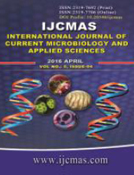


 National Academy of Agricultural Sciences (NAAS)
National Academy of Agricultural Sciences (NAAS)

|
PRINT ISSN : 2319-7692
Online ISSN : 2319-7706 Issues : 12 per year Publisher : Excellent Publishers Email : editorijcmas@gmail.com / submit@ijcmas.com Editor-in-chief: Dr.M.Prakash Index Copernicus ICV 2018: 95.39 NAAS RATING 2020: 5.38 |
Salmonella typhi has been the most common aetiological agent of enteric fever syndrome while S. paratyphi A is responsible for only a minority of enteric fever cases. Salmonella typhi has also rapidly gained resistance to antibiotics like ampicillin, chloramphenicol and cotrimoxazole, and also to previously efficacious drugs like ciprofloxacin.It is imperative to know the current prevalence of Salmonella serotypes in order to understand vaccination strategy for typhoid. Also knowledge about the resistance pattern of the most predominant serotype is desirous for prescribing antimicrobials. 187 Blood culture specimens were received in BACTEC 9050 Bottles between January 2012 to January 2013 and presumptive isolates identified biochemically and confirmed by slide agglutination antiserum . Antibiotic susceptibility testing was performed by the Kirby Bauer disk diffusion method to the following antibiotics were put up(µg) : levofloxacin (5), nalidixic acid (30), ciprofloxacin (5), cefepime (30),cefotaxime(30)/ ceftriaxone (30)and azithromycin(15) (Hi-Media Laboratories Ltd, Mumbai). In addition first line antimicrobials like chloramphenicol(30), ampicillin (10), trimethoprim/sulfamethoxazole (25) were also put up. Out of 187 blood cultures, 30 Salmonella typhi and 8 Salmonella paratyphi were identified. The Salmonella typhi were resistant to the antimicrobials as follows : Ampicillin 66.7%, chloramphenicol 10.0%, cotrimoxazole 26.7%,cefixime 9.75% ,cefepime 8.32%,cefotaxime/ceftriaxone 10.32 %, ,levofloxacin 4.1%, ciprofloxacin 13.3%,Nalidixic acid 96.7% and Azithromycin 14.2%,e presence of MDR (i.e resistance to ampicillin, chloramphenicol and co-trimoxazole) was 10%. The evidence suggests that Salmonella typhi is still the predominant serotype followed by Salmonella paratyphi A with the rates of isolation of latter being more or less constant over the past decade .The evidence also suggests that the fluoroquinolones are the optimal choice for the treatment of typhoid fever in adults and that they may also be used in children inspite of resistance to nalidixic acid. The use of ceftriaxone and other third generation cephalosporins should be used only in case of non responsiveness to fluoroquinolones.
Ruchi Girotra, Reetika Dawar, Ruby naz, Sunil Garg and Rakesh Gupta. 2016. Prevalence of Salmonella serotypes and antibiogram of Salmonella typhi in a Tertiary Care Hospital in NCR Region, India.
Int.J.Curr.Microbiol.App.Sci. 5(4): 803-810. doi: http://dx.doi.org/10.20546/ijcmas.2016.504.092 |
 |
 |
 |
 |